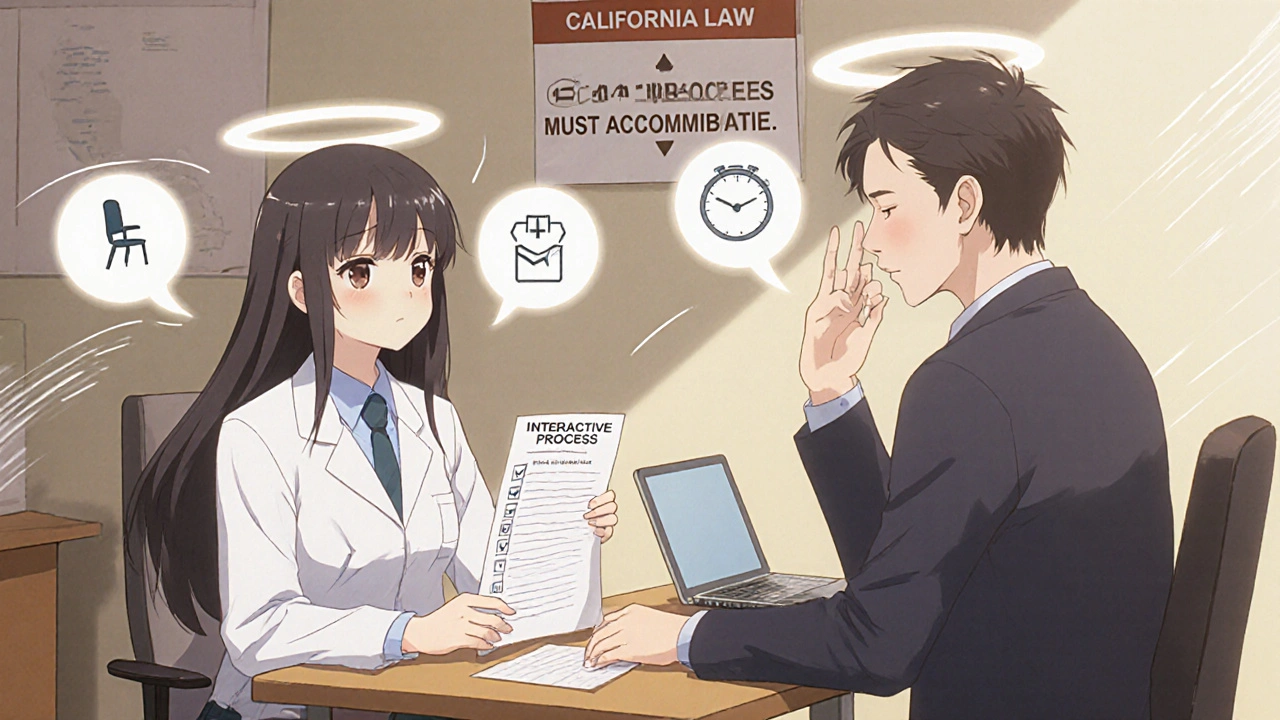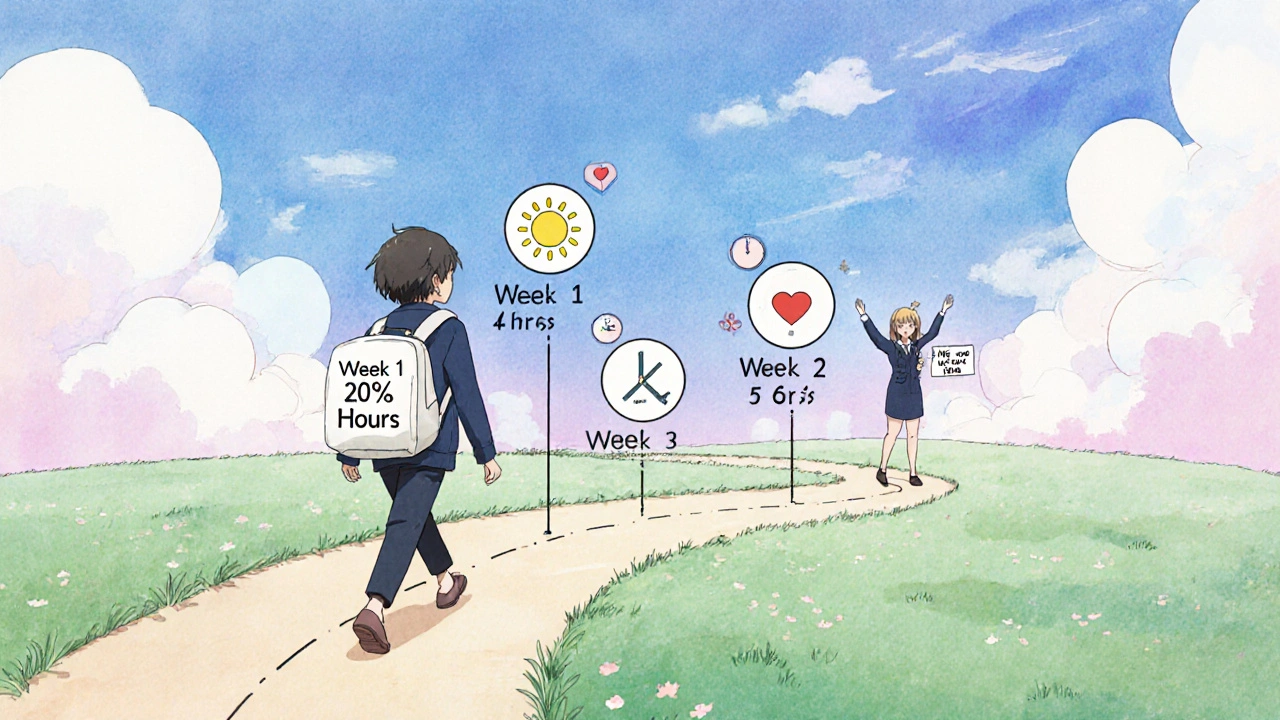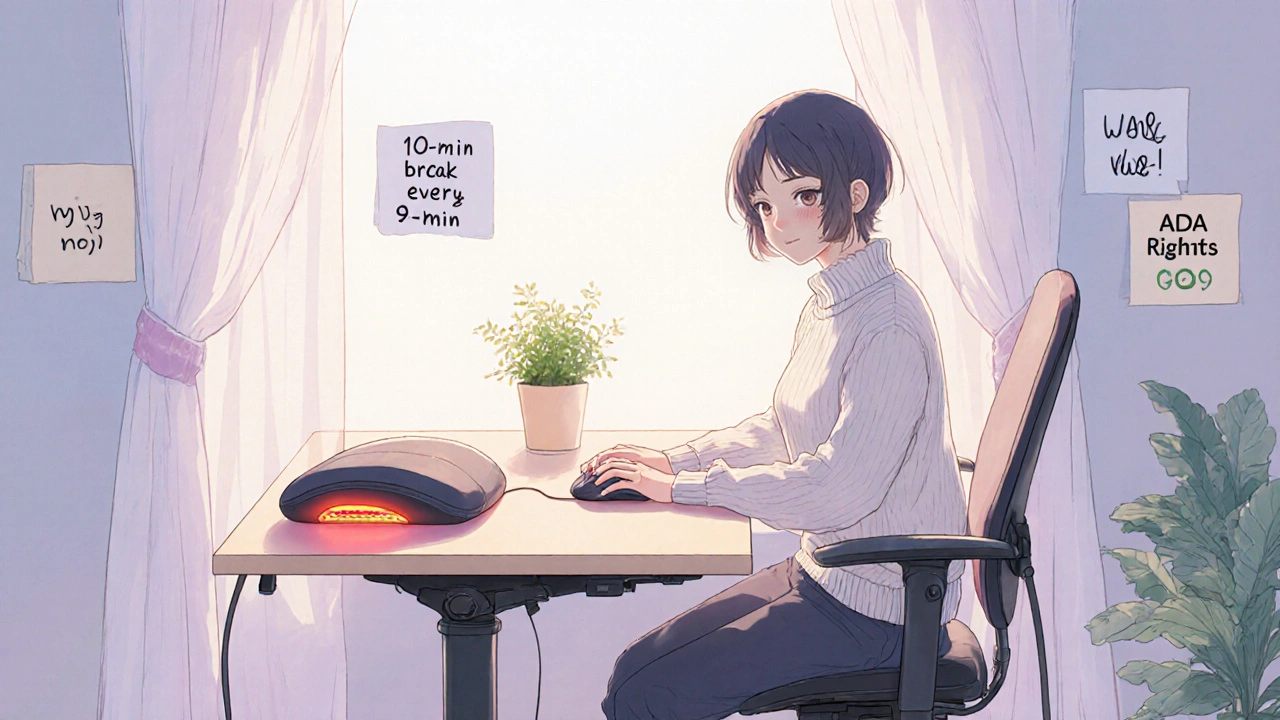Returning to work with chronic pain isn’t about pushing through the discomfort. It’s about creating a plan that lets you work without making your pain worse. Too many people assume they have to choose between their job and their health. That’s not true. With the right accommodations and a clear strategy, you can stay employed and manage your pain at the same time.
What Counts as Chronic Pain at Work?
Chronic pain isn’t just a bad back or a sore knee that lasts a few days. It’s pain that sticks around for three months or longer and interferes with your ability to do everyday tasks - including your job. Under the Americans with Disabilities Act (ADA), chronic pain qualifies as a disability if it limits major life activities like sitting, standing, walking, or concentrating. That means you’re legally protected, and your employer must make reasonable changes to help you do your job.
It doesn’t matter if your pain comes from arthritis, fibromyalgia, nerve damage, or long COVID. If it affects your work, you have rights. The Equal Employment Opportunity Commission (EEOC) made this clear in 2021: employers can’t ignore requests for help just because the pain isn’t visible. In fact, between 2021 and 2022, ADA requests tied to chronic pain went up by 17% - and musculoskeletal issues like back pain made up 34% of all disability claims.
What Kind of Accommodations Are Available?
Accommodations aren’t luxury perks. They’re practical, low-cost fixes that let you work without worsening your condition. And here’s the surprising part: 56% of accommodations cost nothing to implement, according to the Job Accommodation Network (JAN). The rest? The median one-time cost is just $300.
Here’s what works in real workplaces:
- Ergonomic furniture: Adjustable standing desks ($300-$1,200), ergonomic chairs ($200-$1,000), and supportive cushions ($50-$200) reduce pressure on joints and muscles. A heated massage cushion (around $85) plugged into a standard outlet can ease flare-ups during the day.
- Input devices: Special keyboards and mice that reduce wrist strain cost as little as $50. Voice recognition software ($100-$300) lets you type without using your hands at all.
- Flexible scheduling: Starting work later to avoid morning stiffness, ending early to rest, or taking 5-15 minute breaks every 1-2 hours can make a huge difference. Many people find they’re more productive with short, frequent pauses than long, painful stretches.
- Remote work: Working from home full-time or part-time removes commuting stress and lets you control your environment - temperature, lighting, seating. This is especially helpful for conditions like multiple sclerosis, where heat can trigger symptoms.
- Workstation changes: Moving your desk closer to the bathroom or printer, switching to a ground-floor office, or reorganizing your space to reduce reaching and bending can cut pain triggers.
- Duty adjustments: If you can’t lift heavy boxes or stand for hours, your employer can shift those tasks to someone else. You keep your job, your title, your pay - just not the parts that hurt you.
California’s rules are even stronger than federal law: employers with just five employees must provide accommodations. Most other states follow the federal 15-employee threshold, but the trend is moving toward broader protection.
The Interactive Process: How to Ask Without Getting Rejected
Asking for help is the hardest part - and the most important. Sixty-two percent of people with chronic pain delay requesting accommodations because they’re afraid of being seen as weak, lazy, or difficult. But silence doesn’t protect you. It costs you your job.
The law requires an interactive process: a back-and-forth between you and your employer to find a solution. This isn’t a one-time email. It’s a conversation.
Here’s how to do it right:
- Document your pain. Get a note from your doctor that says: your diagnosis, what your pain limits you from doing (e.g., “cannot sit for more than 45 minutes without increased pain”), and what accommodations would help. Don’t say “I need help.” Say “I need a sit-stand desk and 10-minute breaks every 90 minutes to manage lower back pain.” Specificity cuts denial rates by 55%.
- Put it in writing. Send an email to your manager and HR. Mention the ADA. Say: “Per the ADA, I request reasonable accommodations to continue performing my job duties. My healthcare provider has recommended [list accommodations]. I’m happy to discuss alternatives if needed.”
- Be ready to negotiate. Your employer doesn’t have to give you exactly what you ask for - they just have to give you something that works. If they suggest a cheaper chair instead of a standing desk, try it for two weeks. If it doesn’t help, say so and ask again.
- Use free help. The Job Accommodation Network (JAN) offers free, confidential advice to employees and employers. They’ve helped resolve 82% of accommodation issues without formal complaints.
Employees who are specific about their needs get approved 89% of the time. Those who say “I need something to help with my pain”? Only 45% approval.

What If Your Employer Says No?
Employers can refuse accommodations only if they prove it would cause “undue hardship” - meaning it’s too expensive or disruptive for their size. But that bar is high. A small business with 10 employees can’t claim hardship because a $300 chair is “too much.” A big company can’t say “we don’t do that” just because it’s not standard policy.
Here’s what counts as undue hardship:
- The cost would bankrupt the company (unlikely for anything under $5,000)
- The accommodation would disrupt core operations
- It would require hiring someone else to do your job
Most denials happen because employers don’t understand chronic pain. They think accommodations are temporary fixes. But pain doesn’t follow a schedule. A back injury might flare up after a long meeting or during a cold snap. That doesn’t mean you’re unreliable - it means your body works differently.
If you’re denied, ask for the reason in writing. Then contact the EEOC or your state’s civil rights agency. In 2022, federal agencies approved 87% of chronic pain accommodation requests. Private employers should be held to the same standard.
Gradual Return: Don’t Jump Back In
If you’ve been off work for weeks or months, jumping straight back to 40 hours a week is a recipe for burnout - and more pain. A better path? A graduated return to work.
This means starting with 20-50% of your normal hours. You might work 9 a.m. to 1 p.m. for the first two weeks, then add an hour each week. You keep your full salary. You still get your accommodations. And you give your body time to adjust.
Research shows this approach leads to 63% higher long-term job retention than jumping right back in. You’re not quitting. You’re strategizing.

Why Coworkers and Supervisors Matter
Accommodations aren’t just about desks and schedules. They’re about culture.
Employees with strong relationships with coworkers are 2.3 times more likely to have their requests approved. Why? Because when people understand your pain, they’re more willing to cover for you, adjust deadlines, or just give you space.
Supervisors who get training on chronic pain are far more likely to support accommodations. If your manager thinks pain is “all in your head,” they won’t help - even if the law says they must.
Consider sharing a short, factual handout with your team: “I have chronic pain. It affects my energy and mobility, but I’m fully capable of doing my job. I’m using accommodations to stay productive. Thanks for your support.”
It’s not about sympathy. It’s about clarity.
What to Do Next
If you’re thinking about returning to work with chronic pain, here’s your action plan:
- Get medical documentation that links your pain to specific work limitations.
- Write down exactly what you need - not “help,” but “a sit-stand desk and 10-minute breaks every 90 minutes.”
- Send your request in writing to HR and your manager. Mention the ADA.
- Call JAN (1-800-526-7234) or visit askjan.org. They’ll help you draft your request and explain your rights.
- If you’re denied, ask for the reason in writing. Then contact your state’s civil rights office or the EEOC.
- Start slow. A graduated return is safer, smarter, and more sustainable.
You don’t have to quit your job to manage your pain. You just have to know your rights - and be willing to ask for what you need. The system works when you use it.
Can my employer fire me for having chronic pain?
No. Under the ADA, firing someone because of chronic pain that qualifies as a disability is illegal. Employers must provide reasonable accommodations unless doing so causes undue hardship. If you’re terminated after requesting accommodations, you may have grounds for a discrimination claim.
Do I need to tell my employer about my chronic pain?
You’re not required to disclose your diagnosis, but you must tell your employer you have a medical condition that affects your work if you want legal protections. You can say, “I have a medical condition that impacts my ability to sit for long periods,” without naming the diagnosis. But to get accommodations, you’ll need to provide medical documentation.
Can I get accommodations if I work for a small company?
Under federal law, companies with fewer than 15 employees aren’t required to provide ADA accommodations. But some states, like California, require accommodations for employers with 5+ employees. Even if not legally required, many small businesses still offer accommodations - especially if they’re low-cost or free. It never hurts to ask.
What if my pain flares up and I need more time off?
The Family and Medical Leave Act (FMLA) gives you up to 12 weeks of unpaid, job-protected leave per year - but only if you work for a company with 50+ employees and you’ve worked 1,250 hours in the past year. If you need more time, you can request leave as an accommodation under the ADA. Employers must consider it unless it causes undue hardship. Many employers grant extra time on a case-by-case basis.
Can I use my sick leave for chronic pain accommodations?
Yes. If you need extra breaks or time off for medical appointments, you can use accrued sick leave or personal time. Some employers allow you to use leave in small increments (like 15 minutes at a time). This is often easier than taking a full day off. Your employer can’t force you to use all your leave before approving other accommodations - they must consider both.
